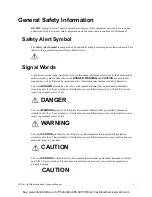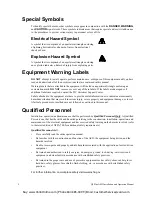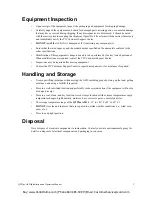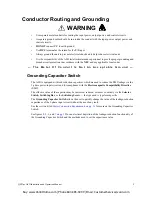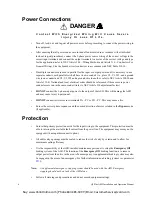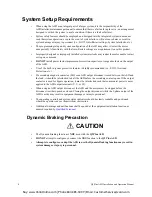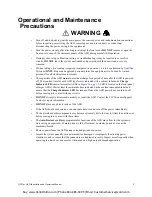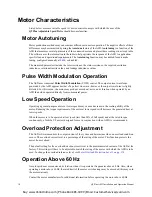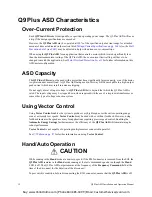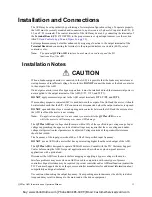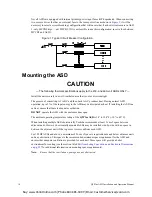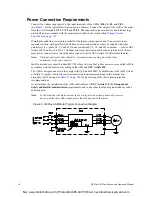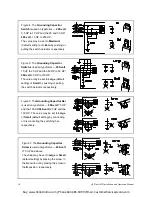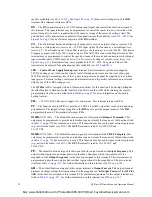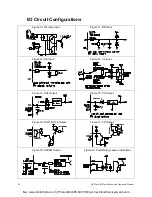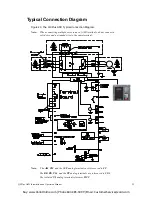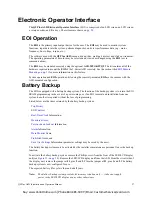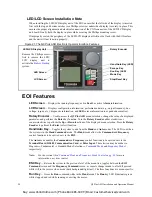
Q9 Plus ASD Installation and Operation Manual
13
Installation and Connections
The ASD may be set up initially by performing a few simple configuration settings. To operate properly,
the ASD must be securely mounted and connected to a power source (3-phase AC input at the R/L1, S/
L2, and T/L3 terminals). The control terminals of the ASD may be used by connecting the terminals of
the
Terminal Board
(P/N 072314P903) to the proper sensors or signal input sources (see the section
titled
I/O and Control on pg. 20
and
Figure 9 on pg. 23
).
System performance may be further enhanced by assigning a function to the output terminals of the
Terminal Board
and connecting the terminals to the proper indicators or actuators (LEDs, relays,
contactors, etc.).
Note:
The optional
Q9 Plus ASD
interface
boards
may be used to expand the I/O
functionality of the ASD.
Installation Notes
When a brake-equipped motor is connected to the ASD, it is possible that the brake may not release at
startup because of insufficient voltage. To avoid this,
DO NOT
connect the brake or the brake contactor
to the output of the ASD.
If an output contactor is used for bypass operation, it must be interlocked such that commercial power is
never applied to the output terminals of the ASD (U/T1, V/T2, and W/T3).
DO NOT
apply commercial power to the ASD output terminals
U/T1
,
V/T2
, and
W/T3
.
If a secondary magnetic contactor
(MC) is used between the output of the ASD and the motor, it should
be interlocked such that the
ST – CC
connection is disconnected before the output contactor is opened.
DO NOT
open and then close a secondary magnetic contactor between the ASD and the motor unless
the ASD is off and the motor is not rotating.
Note:
Re-application of power via a secondary contact while the
Q9 Plus ASD
is on or
while the motor is still turning may cause ASD damage.
The
Q9 Plus ASD
input voltage should remain within 10% of the specified input voltage range. Input
voltages approaching the upper or lower-limit settings may require that the over-voltage and under-
voltage stall protection level parameters be adjusted. Voltages outside of the permissible tolerance
should be avoided.
The frequency of the input power should be ±2 Hz of the specified input frequency.
DO NOT
use an ASD with a motor that has a power rating higher than the rated output of the ASD.
The
Q9 Plus ASD
is designed to operate NEMA B motors. Consult with the TIC Customer Support
Center before using the ASD for special applications such as with an explosion-proof motor or
applications with a piston load.
Disconnect the ASD from the motor before megging or applying a bypass voltage to the motor.
Interface problems may occur when an ASD is used in conjunction with some types of process
controllers. Signal isolation may be required to prevent controller and/or ASD malfunction (contact the
TIC Customer Support Center or the process controller manufacturer for additional information about
compatibility and signal isolation).
Use caution when setting the output frequency. Over-speeding a motor decreases the ability to deliver
torque and may result in damage to the motor and/or the driven equipment.
CAUTION
Buy: www.ValinOnline.com | Phone 844-385-3099 | Email: CustomerService@valin.com



